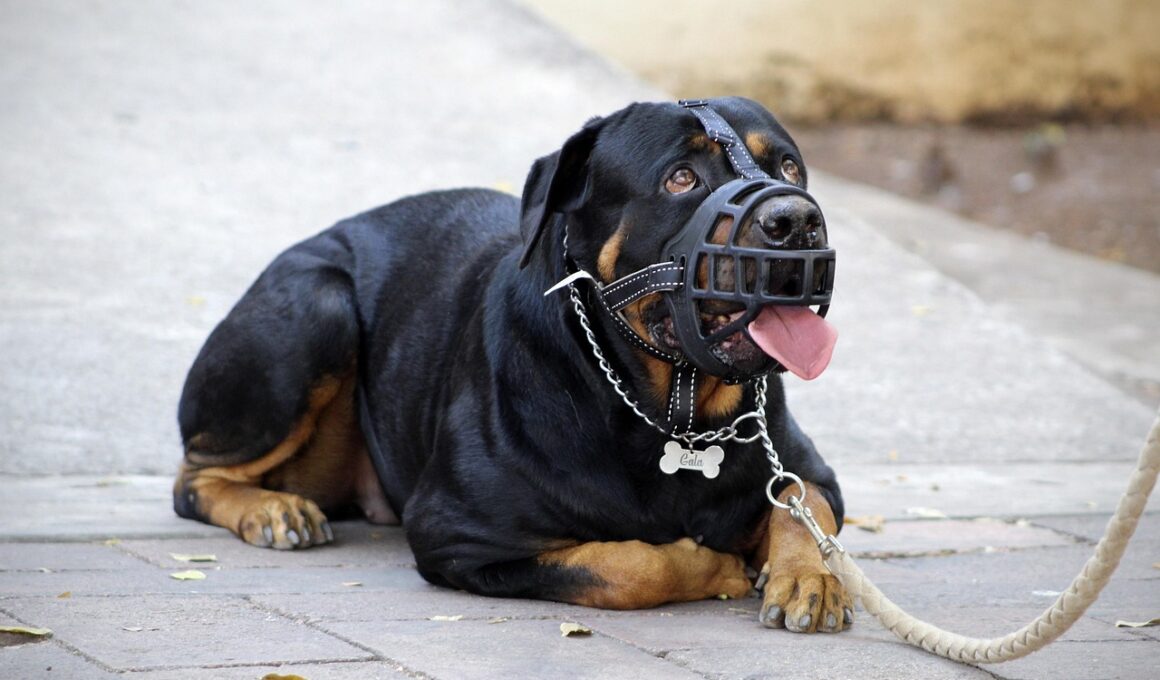The Influence of Age on Territorial Behavior in Dogs
Understanding territorial behavior in dogs is crucial for owners and trainers alike. As dogs mature, their territorial instincts significantly evolve, influencing their reactions to various stimuli. Young dogs may exhibit playfulness, often confusing territoriality with social interaction. However, as they enter their adult years, they tend to demonstrate a stronger inclination to defend their perceived territory. This heightened awareness can lead to aggressive responses when strangers or other animals encroach on their space. Factors such as breed, experiences, and environment also contribute to territorial behavior development. By observing these patterns, owners can better manage their dog’s reactions in various situations. It’s essential to implement effective training practices that foster positive associations with territorial spaces. Gradual socialization is key in ensuring that dogs learn to differentiate between genuine threats and benign visitors. Understanding these behaviors during puppyhood can mitigate potential territorial issues in adulthood. Implementing routine exercises and training activities promotes confidence and reduces anxiety, further minimizing negative responses. In conclusion, recognizing the role of age in shaping territorial behavior is vital for fostering a well-adjusted companion.
As dogs progress through their life stages, their perception of territory naturally shifts. Age influences not just physical capabilities but also mental adaptability. Senior dogs may exhibit reclusive behavior, often seeking comfort in familiar surroundings. This retreat can sometimes be mistaken for territorial aggression when they feel threatened. On the other hand, younger dogs may challenge boundaries, testing their limits as they grow. This exploratory behavior is critical as it allows them to establish their territory. Awareness of a dog’s age-related behavior ensures appropriate measures to protect them and ease their anxieties. Training becomes even more crucial in later years, emphasizing a balance between independence and reassurance. Engaging senior dogs with memory-based games can help maintain their cognitive functions while sparking their territorial instincts healthily. Owners should encourage relaxed environments where dogs feel secure and less inclined to assert dominance unnecessarily. Recognizing the difference between genuine territorial defense and stress-induced behavior can aid in effective training approaches. Such insights not only foster peace between pets and visitors but also enrich the overall quality of life for aging dogs.
Factors Affecting Territorial Behavior
Several factors influence a dog’s territorial behavior, including genetics, socialization, and previous experiences. Genetic predisposition plays a significant role in shaping how intensely a dog may defend its territory. Certain breeds are naturally more protective and assertive when it comes to guarding their space. For instance, breeds like Rottweilers and German Shepherds are often more territorial compared to more social breeds like Beagles. Socialization during the crucial early months greatly impacts behavior later in life. Dogs that are regularly exposed to various environments tend to be more adaptable and less likely to react aggressively when their territory is compromised. Owners should facilitate positive interactions with other animals and people, thus promoting a sense of safety in their environment. Furthermore, prior traumatic experiences can lead to heightened territorial instincts. A dog that has faced an invasion or an inconsiderate encounter may become increasingly defensive. Consequently, by understanding these underlying factors, owners can better anticipate their dogs’ reactions, leading to more effective training and management strategies that focus on nurturing and trusting relationships.
It’s essential for dog owners to recognize the signs of territorial behavior and adjust their training practices accordingly. These signs may include growling, barking, or standing tall to assert dominance over a specific area. Awareness and timely intervention can prevent problems from escalating. When dogs display aggressive territorial behavior, owners should remain calm and avoid punishment, which can intensify fear and anxiety. Instead, redirecting the dog’s attention to positive reinforcements can cultivate a sense of security. Using treats and praise to reward calm behavior can dramatically shift a dog’s response to various territorial situations. Training should also emphasize establishing boundaries, teaching dogs about acceptable interactions with strangers and familiar guests. Consistency is key; the same rules must apply across all environments to avoid confusing the dog. As dogs age, their territorial behavior may soften; thus, regular assessment and adaptation of training techniques are vital. Ongoing socialization can assist older dogs in maintaining balance in territorial behavior, promoting their overall well-being. A supportive approach combines understanding, patience, and the willingness to adapt to an evolving understanding of a dog’s behavior through different life stages.
The Importance of Routine and Environment
The environment in which a dog resides significantly impacts its territorial behavior. Dogs thrive in stable environments marked by predictability, which fosters confidence and reduces anxiety. A chaotic or unpredictable setting can lead even the most placid dogs to feel threatened, prompting territorial responses. Implementing a daily routine, including consistent feeding, exercise, and social interactions, can greatly improve a dog’s comfort level and security. Providing a secure, defined space for your dog can also contribute to minimizing territorial aggression. Elements such as a designated bed, toys, and boundaries will establish a sanctuary for the dog, reassuring it that its territory is respected and safe. When a dog feels grounded, it’s less likely to perceive external stimuli as threats. Engaging them in structured activities also provides mental stimulation that can divert focus from territorial impulses. Positive reinforcement for calm behavior and gradually introducing new animals or people can help navigate potential territorial issues. An overall nurturing environment reduces stress and encourages healthy interactions, resulting in a more harmonious living space. Owners should continually assess and adjust routines in response to their dog’s evolving territorial needs as they mature.
In addition to training and environment, the role of exercise cannot be overstated in managing territorial behavior in dogs. Regular physical activity reduces pent-up energy that might otherwise be exhibited through territorial displays. A well-exercised dog is less likely to engage in unwanted behaviors related to defending its space. Daily walks, play sessions, and mental challenges are critical outlets that promote relaxation and a positive state of mind. Age-appropriate exercises geared towards maintaining mobility and vitality can enrich the dog’s life and expand its boundaries. For example, older dogs may benefit from gentle walks in familiar areas, allowing them to feel safe while exploring their territory. Engaging dogs in interactive play can also foster a stronger bond between the owner and pet, reinforcing trust and security. Moreover, mental stimulation from problem-solving games or obedience training can enhance a dog’s ability to focus and distinguish between true threats and safe interactions. Therefore, incorporating comprehensive exercise regimes tailored to the dog’s age and physical capabilities lays a foundation that combats anxiety and restores balance to territorial responses.
Final Thoughts on Territorial Behavior
In conclusion, understanding the influence of age on territorial behavior is paramount in nurturing a well-behaved canine companion. Recognizing how developmental stages affect instincts provides the foundation for effective training and relationship-building strategies. As dogs age, their needs and responses to their environment will evolve, necessitating consistent adaptations in training protocols. Patience, compassion, and awareness are essential ingredients in addressing territorial behavior. Observing the cues that signify ownership, anxiety, or fear leads to informed choices in managing reactions. Furthermore, the combination of exercise, structured routines, and positive reinforcement creates a balanced approach to navigating territorial instincts. Owners should also embrace the journey of learning about their dog’s evolving personality, responding to the changes that come with age gracefully. Ultimately, a well-adjusted dog reflects a dedicated owner’s investment in understanding and caregiving. By emphasizing socialization, routine, and training, owners foster dogs equipped to handle their territorial instincts effectively. With conscious efforts, dogs can transition gracefully through their life stages, maintaining peace and balance both within their territory and their relationships with humans and other animals.
Integrating knowledge about dog territorial behavior into your daily routines will enhance not just your dog’s life but also your shared experiences. Creating positive environments ensures that your pet feels secure and confident is crucial for owners to facilitate quality lives for their dogs. Territorially motivated actions require management and adaptability, showcasing the importance of blending physical and attentive exercises. Engaging with your dog in understanding their environment, learning their thresholds, and respecting personal space heightens trust levels and success in daily interactions. Observers notice how well-adjusted dogs contribute to their owners’ lifestyles as well. In essence, fostering growing bonds involves an appreciation for both their territorial instincts and valuable companionship. Owners must grasp not only the behavioral aspects but embark on a journey of empathy. Dogs are incredibly perceptive, and with the proper guidance, they blossom into confident and well-rounded pets. This relationship, built on trust and understanding, showcases the profound impact of age on dogs. It becomes essential to remain proactive in recognizing both new challenges and celebrating victories in their maturity. Through careful observation and dedicated training, territorial behaviors can evolve into positive characteristics, further enriching the human-animal bond.


